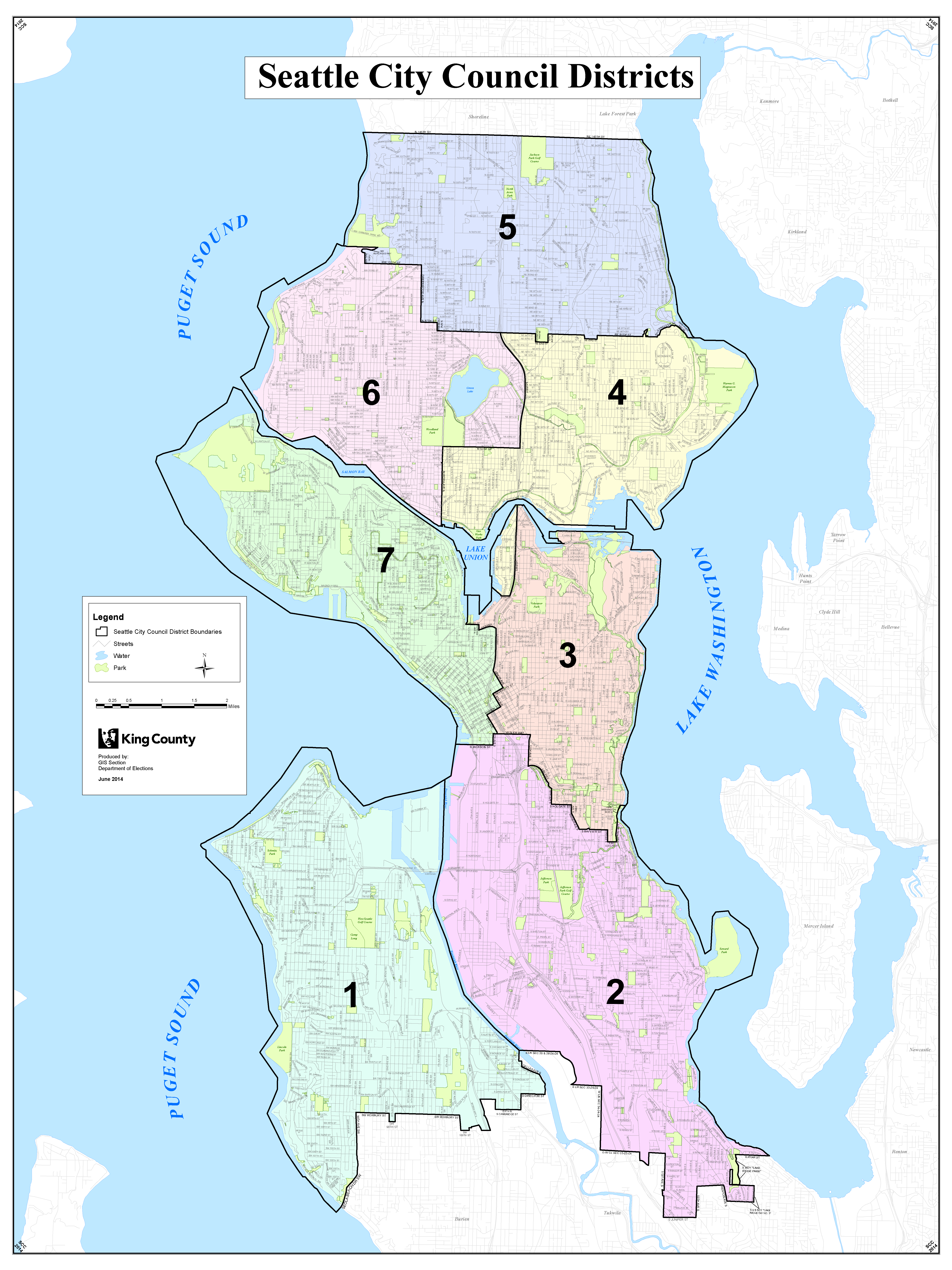
Ahead of the 2023 election, the seven Seattle City Council districts are set to be redrawn using 2020 U.S. Census figures to rebalance each district’s population level. The bureau’s population estimate for Seattle came back surprisingly low — 24,000 lower that the April 2020 estimate of 761,100 from the Washington State Office of Financial Management — which may decrease the amount of border shifting required.
Even so, some significant moves will happen. In short, District 7 will need to get much smaller and Districts 1, 2, and 5 will need to get a bit bigger to get within range of the average council district population. The rest are pretty close to the population average, but may need to see borders shifts in order to facilitate the needed precinct swaps among the districts that differ from the average significantly. Containing Seattle’s fast-growing downtown core, District 7 is most out of balance, exceeding the average by 18,063 residents.
On the other end of the equation, District 5’s census tally was 6,126 residents below the average district. As the northernmost district, it borders only Districts 4 and 6 which both came in pretty close to the average. So District 5 (D5 and so on for others) will take from either or both, and then the donor district will have to make up the difference from one of the more populated districts that neighbor it. Many prognosticators, such as SCC Insight‘s Kevin Schofield, forecast District 5 will absorb Crown Hill, a prediction which has a geographic logic to it since Crown Hill is the northernmost neighborhood not already in D5. In such a scenario, District 6 would then need to grow a bit elsewhere, and North Magnolia seems the likeliest option to provide that growth followed by Fremont. D6 is currently underpopulated and will likely expand anyway, while D4 is well within the acceptable range, so it wouldn’t necessarily require a border shift.
Districts, however, don’t have to be right at the population average. “The rules for redistricting require that the district boundaries must be adjusted so that the difference in population between the largest and smallest districts is no larger than 1% of the entire population (using the official 2020 census numbers),” Schofield explained. “According to the census, the total population of Seattle is 737,015. That means all seven districts will need to be within 7,370 people of each other.” Dividing this total maximum difference would give us 3,685 on either side of the average, but the redistricting commission may opt to keep districts much closer to average population to keep things fairer and simpler.
| Council District | 2010 Census | 2019 Estimate | 2020 Census | Growth rate | Difference from mean | 2019 Difference from mean |
|---|---|---|---|---|---|---|
| 1 | 86,785 | 99,700 | 99,698 | 14.88% | -5,590 | -7,029 |
| 2 | 87,268 | 101,900 | 99,163 | 13.63% | -6,125 | -4,829 |
| 3 | 86,558 | 113,200 | 106,845 | 23.44% | 1,557 | 6,471 |
| 4 | 87,677 | 109,000 | 106,103 | 21.02% | 815 | 2,271 |
| 5 | 86,950 | 98,300 | 99,102 | 13.98% | -6,186 | -8,429 |
| 6 | 86,771 | 101,100 | 102,753 | 18.42% | -2,535 | -5,629 |
| 7 | 86,651 | 123,900 | 123,351 | 42.35% | 18,063 | 17,171 |
| Total | 608,660 | 747,100 | 737,015 | 21.09% | 105,288 | 106,729 |
The exchange between Districts 1, 2, and 7 is where things get really complex. District 1 only borders District 2 currently with the Duwamish River the dividing line. That means District 1 must absorb part of District 2 to take on enough population, with SoDo or Georgetown constituting the options just across the border. But District 2 is also underpopulated so it will need to take from District 3 or 7 or both to make up the difference. District 7 has plenty of population to give, but District 3 is barely over the average after its census total came in surprising low — more than 6,000 residents lower than its 2019 population estimate had forecast. Whether a possible effect of Trump administration meddling or a real pandemic-induced population dip reflected in greater Capitol Hill’s diminished population numbers, the Census figures — undercount or not — are what they are.
District 3 is close enough to the district population average to not require border changes. Still, there’s a strong case to be made that D2 should absorb more of Mount Baker and North Rainier from D3 rather than snake north into Pioneer Square to take from D7. D3 would then take from D7 in First Hill or Cascade (the eastern area of South Lake Union that abuts I-5) to make up the difference. This jives with guidance to keep district shapes simple and neighborhoods together as much as practical, but they are not the only solutions. Roughly speaking such a trade would go something like this:
- D1 takes about 5,000 residents from D2.
- D2 takes about 11,000 residents from D3.
- D3 takes about 9,000 residents from D7.
- D5 takes about 5,000 residents from D6.
- D6 takes about 8,000 residents from D7.
Political implications
Most sitting councilmembers appear to have no risk of being redistricted out of their district. The exception is Councilmember Kshama Sawant, who owns a home in Leschi, pretty close to the southern border of her district. D2’s border will move north somewhere, either in Leschi or farther west. It’s also possible a natural boundary like I-90 will become the new district border, which would spare Sawant from being districted out.
Based on the 2019 population data, District 3 was overpopulated by more than 6,000, but the official Census estimate put the district population at 6,355 residents lower than the 2019 estimate almost negating the overpopulation predicted. Because several other districts saw their estimates decrease too, District 3 still ended up slightly overpopulated — though only by 1,557. So, rather than having enough population to donate to D2, D3 is going to need to take from D7 if it’s going to be D2’s primary donor.
More potential impacts of districting changes
In short, D3 could lose some strong progressive districts in the south, but it could gain some progressive leaners from D7 just to the west. Ironically, if it loses Leschi, the district makeup could become more decidedly progressive even if Sawant has to move to run for reelection — and of course she has a recall effort to dispatch first too on the existing map.
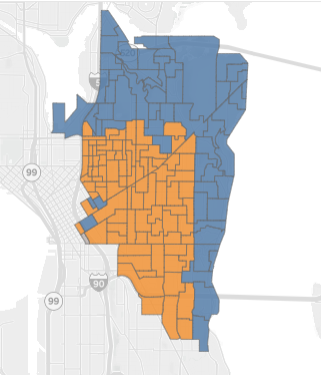
Kshama Sawant decisively carried the historically redlined portion of district, where minority communities were formerly confined and denied loans. These area also the densest precincts. Egan Orion did well in mansion land. (Viz by Jason Weill) 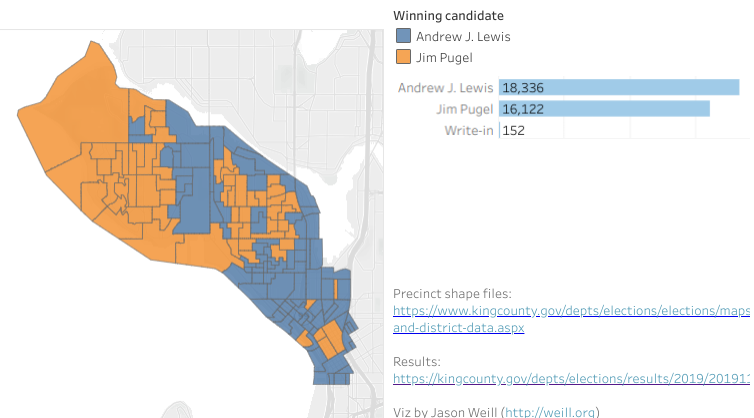
Uptown, Belltown and the Denny Regrade carried D7 for Andrew Lewis, whose precincts are in blue. Surprisingly little of D7 is designated an urban village and that almost tipped the race to Jim Pugel. (Viz by Jason Weill)
D2, meanwhile, would appear set to get only more lefty in its political lean. Picking up more of North Rainier and the Central Area would likely add in D2’s progressive lean, aiding reelection chances for Councilmember Tammy Morales, which already looked pretty strong after a resounding 21-point win in 2019. That said, Georgetown, if that’s what D2 ends up donating to D1, is also pretty favorable to progressives like Morales.
D1 gaining Georgetown would likely help Councilmember Lisa Herbold retain her seat. She won by 12 points in 2019, so she may already be a heavy favorite anyway.
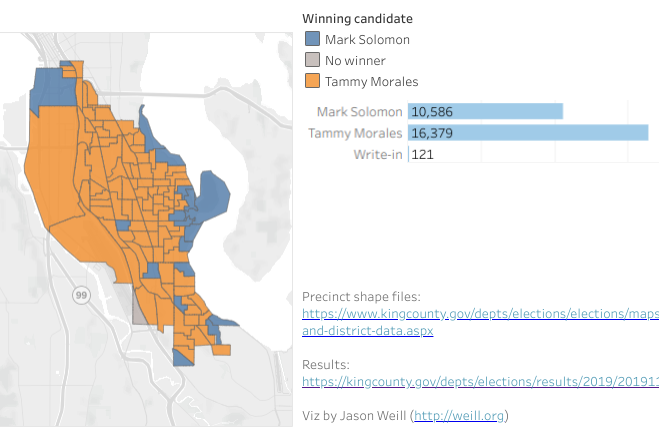
It was decisive win for Tammy Morales in D2. Mark Solomon did have a beachhead of support along Lake Washington. (Viz by Jason Weill) 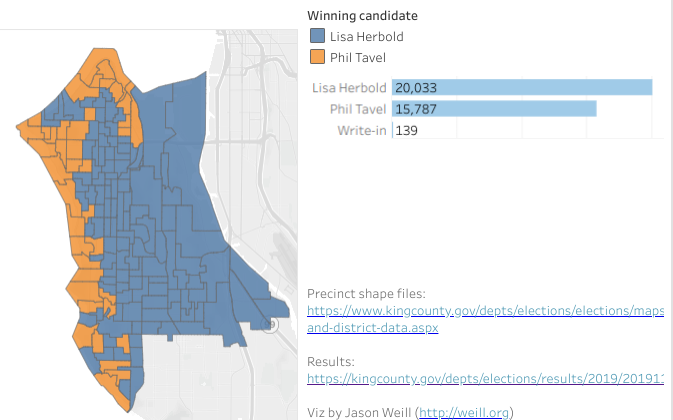
In D1, Lisa Herbold took the urban villages and middle class areas, while Phil Tavel took wealthy areas with Puget Sound views. 55.7% to 43.9% was the final tally. (Viz by Jason Weill)
Picking up Crown Hill could make D5 lean slightly more progressive. Citywide, a pretty consistent pattern of apartment-heavy urban villages (of which Crown Hill is one) favoring progressive candidates has emerged while more suburban single-family areas favor centrist pro-business candidates. Councilmember Debora Juarez has said she will retire at the end of her term so that open seat should make for an interesting race in 2019. Will D5 continue to be a centrist seat or will it swing toward progressives?
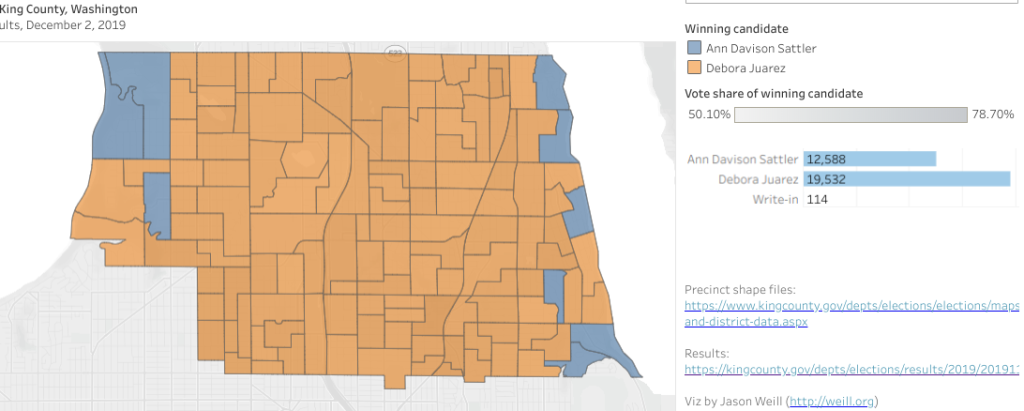
Lots of orange for Debora Juarez. Republican Ann Davison Sattler managed to take some Lake Washington and Puget Sound real estate. (Viz by Jason Weill) 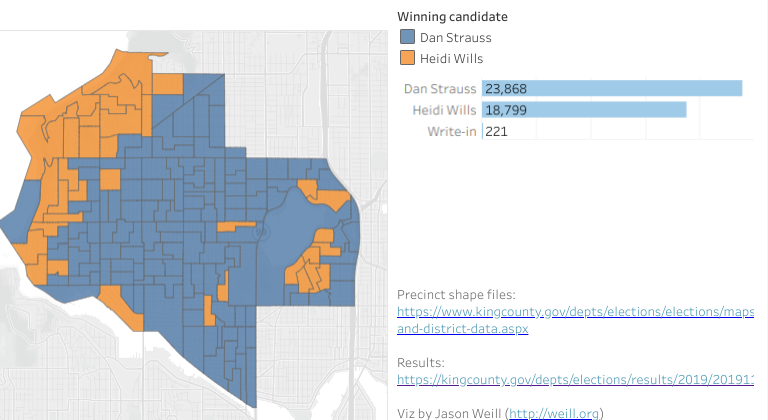
Dan Strauss won just about every precinct from Greenwood to Ballard/Fremont while Heidi Wills (orange) did best near the sound and Green Lake. (Viz by Jason Weill)
D6 meanwhile could become a bit more moderate by losing a progressive voting base in Crown Hill and picking up a moderate one in northern Magnolia. The new map could add a bit of a headwind to Councilmember Dan Strauss’s reelection chances. That said, Strauss did carry the seat convincingly with a 12-point margin against well-financed opponent in former City Councilmember Heidi Wills in 2019. He may have enough margin to weather a less favorable districting map.
D7 is likely to see the biggest border shift, so it’s the hardest to predict how it could change. Losing a chunk of Magnolia would help Councilmember Andrew Lewis since it was one of his weakest neighborhoods in 2019. However, D7 is also like to lose precincts on its eastern border with D2 and D3 that trended progressive. The trade could end being a wash, but it seems the overall D7 trend of high population growth driven by droves of new apartment buildings being built likely favors progressives. Lewis won a close race in 2019 by a 6.4-point margin.
D4 may see no changes to its borders but a similar trend is at play. The majority of the growth is from new apartment buildings and those residents tend to favor progressive candidates. Council’s stalwart conservative in Alex Pedersen won a close race by 4% over socialist urbanist Shaun Scott in 2019. However, even if the borders don’t change, the map could change for Pedersen due to who is moving into the district.
Looking ahead
A draft redistricting plan is due by November 15th when it’s supposed to be released to the public, according to Seattle Redistricting Commission website. The commission will take public comment before voting on a finalized plan. Five members are on the commission; two appointed by the Mayor, two by the City Council, and one appointed by majority vote of the previous four members. Elected officials (save for Precinct Committee Officers), lobbyists, candidates for public office, and City employees are barred from serving on the commission. Applications to serve on the commission have closed and all five selections will likely be announced soon given fast-approaching deadline.
So far, three selection have been announced — two Council appointments and one from the mayor. The selections are Rory O’Sullivan and Eliseo Juarez by the City Council and Greg Nickels by Mayor Durkan, Daniel Beekman reported. Durkan has one more appointment, after which the appointees will chose a fifth member.
Author’s note: This article has been updated with news of the three commission appointments made so far.
Doug Trumm is publisher of The Urbanist. An Urbanist writer since 2015, he dreams of pedestrian streets, bus lanes, and a mass-timber building spree to end our housing crisis. He graduated from the Evans School of Public Policy and Governance at the University of Washington in 2019. He lives in Seattle's Fremont neighborhood and loves to explore the city by foot and by bike.

